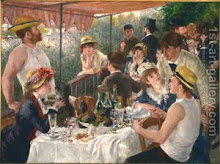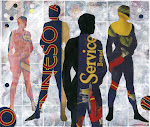Initially you'll have to deliberately work at implementing these painting tips in a painting's composition, but with practice it'll become instinctive.
Tip 1: Where's the Focal Point? The focal point should draw the viewer's eye to it. Place the focal point (the thing that's the main subject of the painting) on one of the 'intersection spots' from the Rule of Thirds, then check the other elements in the painting, which should lead they eye towards this point. It doesn't have to be an overt 'path', such as a road leading to a house; it can be subtle, such as a color repeated in flowers. (Also, don't try to include too much in one painting.)
Tip 2: Did You Use a Viewfinder? Isolate the key elements in a scene and check their placement by using a viewfinder. See Composition Class: Using a Viewfinder and Composition Class: How to Make a Viewfinder.
Tip 3: Are the Values Varied? Do a thumbnail sketch of your painting's composition in just three values: white (light), black (dark), and grey (mid-tone). Now check how much of each value its got. For a strong composition, you want them to be in quite different amounts, not similar. Try this rule to start: "two thirds, one third, and a little bit." For example, two thirds dark in tone, one third light in tone, and a small area or object that's mid-tone.
Tip 4: How Many Elements are There? Have an odd number of elements in the painting rather than even. For the reasons why, see Composition Class: Choosing the Number of Elements.
Tip 5: How Are the Elements Spaced? It's rare to find neat and orderly arrangements of elements in nature. Just think of the difference between a natural forest, where the trees grow any which way, and a plantation, where the trees are planted in evenly spaced rows. Varying the space between the elements in your composition, the angles they lie at, and their sizes makes a painting more interesting.
Tip 6: Are Any Elements Kissing? Kissing, in this context, means just touching. Elements must either be definitely apart or definitely overlapped. No kissing please, as this creates a weak, connected shape which will distract the viewer's eye, causing a momentary pause as they puzzle it out.
Tip 7: Do Warm or Cool Colors Dominate? It doesn't matter whether the overall feeling of the color in a painting is warm or cool, it just shouldn't try to be both.
Tip 8: Is There Unity? Do the elements in the painting's composition feel they belong together, or are they separate bits that just happen to be in the same painting? Help create unity by glazing over the whole painting with a single colour; you can always touch up the highlights again if necessary.
Tip 9: Is the Underlying Composition Obvious? The painting isn't finished yet if the first thoughts of someone seeing your painting is going to be analytical: "There's the focal point, with a spot of yellow to highlight it, that line there leads my eye in, that object was placed there for balance, etc".
Tip 10: Is There Varity? Don't get stuck in a rut and use the same composition all the time, no matter how successful it is. Vary where you put the horizon line, where you put the focal point, swap between portrait (vertical) and landscape (horizontal) shaped canvases.



No comments:
Post a Comment